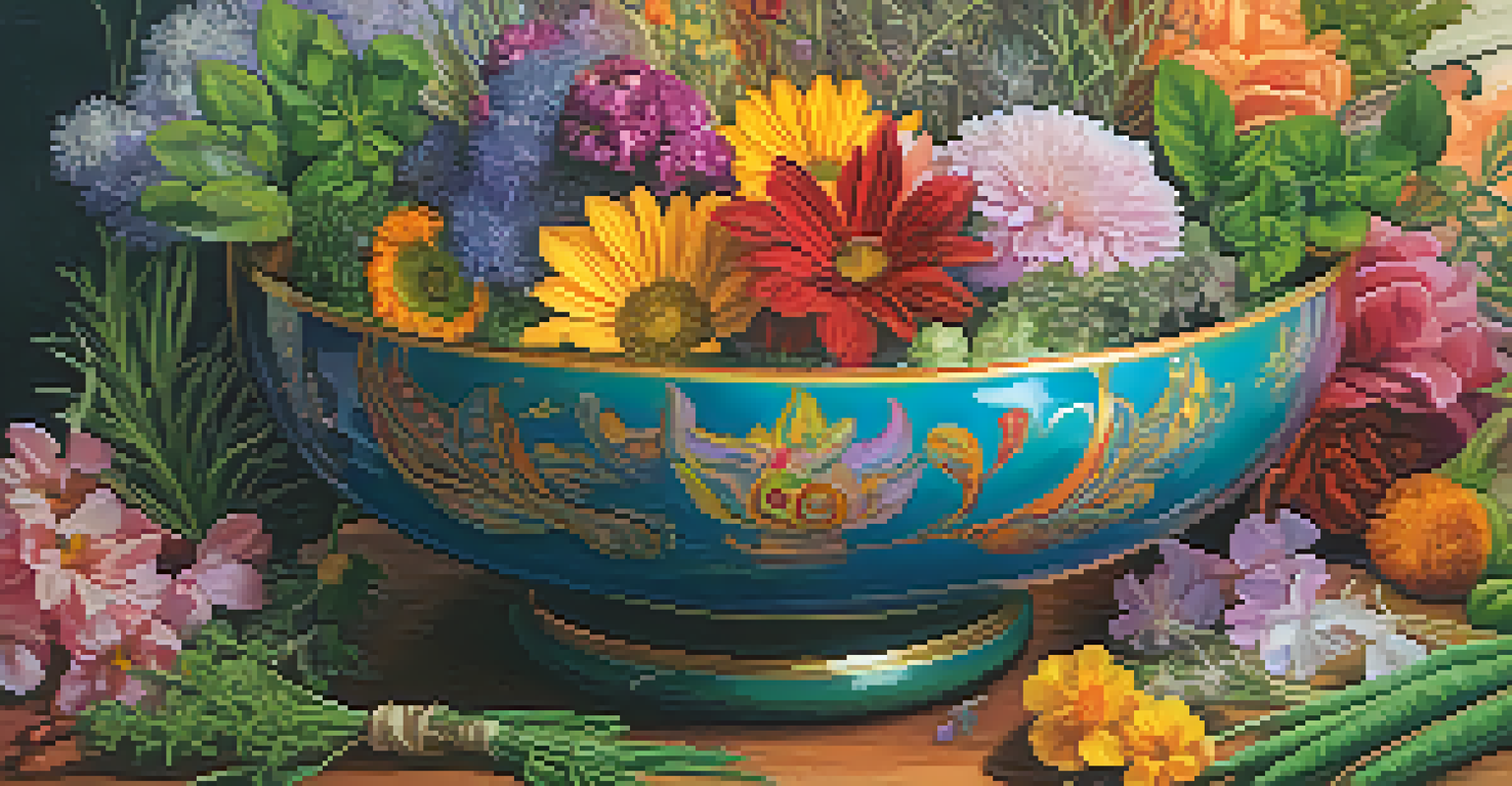Entheogens in Rituals: Strengthening Community Links

Understanding Entheogens: Definition and Significance
Entheogens are substances that are often used in spiritual or religious contexts to facilitate profound experiences. Derived from the Greek words 'entheos,' meaning 'full of the divine,' and 'genesthai,' meaning 'to generate,' these substances can foster a sense of connection to something greater than ourselves. Common examples include psilocybin mushrooms, ayahuasca, and peyote, each with unique cultural implications and uses. By understanding what entheogens are, we can appreciate their role in various rituals across different cultures.
The experience of the sacred is often a communal one, a shared journey that transcends individual differences and fosters deep connections.
Historically, many indigenous communities have incorporated entheogens into their spiritual practices as a means of healing, guidance, and community bonding. These substances often serve as a bridge between the physical world and the spiritual realm, allowing participants to explore their consciousness in ways that promote introspection and connection. For instance, a community might gather for a ceremony where ayahuasca is consumed, facilitating shared experiences that deepen their bonds and collective identity.
In contemporary society, the resurgence of interest in these substances has sparked discussions around their therapeutic potential and role in enhancing community ties. As people seek deeper connections and meaning in their lives, the use of entheogens in rituals can provide a unique avenue for fostering unity and understanding among individuals who share similar desires for growth and exploration.
Rituals: The Framework for Community Connection
Rituals have been a cornerstone of human culture for millennia, serving as structured activities that mark significant life events or transitions. They often provide a sense of belonging and shared identity, which is crucial in fostering community ties. Whether it’s a wedding ceremony, a funeral, or a seasonal celebration, these rituals help individuals connect with one another and reinforce social bonds.

When entheogens are incorporated into rituals, they can enhance the experience by allowing participants to explore their inner selves and the collective consciousness of the group. The shared experience of altered states can lead to profound insights and emotional connections, transforming the way individuals relate to one another. For example, a group participating in a sweat lodge ceremony with peyote may emerge with a greater understanding of each other’s struggles and triumphs, fostering a supportive environment.
Entheogens Foster Community Bonds
Entheogens facilitate shared experiences that deepen emotional connections and promote unity within communities.
Moreover, the intentionality behind rituals signifies their importance in community life. By dedicating time to come together and engage in these practices, communities can create spaces that honor their values and traditions, ultimately strengthening their collective identity. The use of entheogens can amplify these moments, making them not just events, but transformative experiences that reshape relationships and reinforce communal bonds.
The Role of Shared Experiences in Community Building
Shared experiences are vital for fostering a sense of belonging within a community. When individuals come together to participate in rituals involving entheogens, they engage in a collective journey that can break down barriers and promote understanding. This shared journey often leads to deeper emotional connections, as participants navigate the complexities of the experience together.
Rituals are the formulas by which harmony is restored.
For example, participants in a group ayahuasca ceremony may undergo challenging emotional releases, but the support of their peers can create a safe space for healing. This shared vulnerability can lead to lasting friendships and a stronger community bond. Through these experiences, individuals often find common ground and a collective purpose that transcends their individual backgrounds.
The importance of storytelling in these shared experiences cannot be overstated. After a ritual, participants often share their insights and revelations, further solidifying their connections. This practice of storytelling not only reinforces the experiences but also helps to weave the fabric of community life, creating a shared narrative that everyone can relate to and draw strength from.
Cultural Perspectives: Entheogens and Community Rituals
Different cultures have various approaches to utilizing entheogens within their rituals, each reflecting their unique beliefs and values. For example, in Indigenous cultures of the Americas, substances like peyote have been used for centuries in sacred ceremonies that promote communal healing and spiritual growth. These rituals are deeply embedded in the cultural identity of the community, emphasizing their importance in maintaining social cohesion.
Similarly, in Hindu traditions, the use of substances like soma (historically debated) in rituals was believed to connect worshippers with the divine. These cultural practices illustrate how entheogens can serve as a tool for enhancing spiritual experiences, ultimately reinforcing community bonds by creating a shared sense of purpose and belonging. The rituals are not only about the substances themselves but about the stories, traditions, and values they carry.
Rituals Enhance Healing Processes
Incorporating entheogens into rituals allows individuals to explore personal and collective healing, strengthening community ties.
As modern society continues to explore the use of entheogens in a therapeutic context, it’s crucial to respect and honor these cultural perspectives. Understanding the significance of these rituals within their cultural framework can guide contemporary practices, ensuring that they are approached with the reverence and respect they deserve. This mindfulness can lead to more meaningful connections within communities that choose to incorporate entheogens in their rituals.
Healing and Transformation: Entheogens as Community Tools
Entheogens are often viewed as powerful catalysts for healing and transformation, both on an individual and community level. When individuals participate in rituals involving these substances, they often experience profound shifts in perspective and emotional release, which can positively impact their relationships with others. This healing process can lead to a more compassionate and understanding community environment.
For instance, communities grappling with trauma may find solace in rituals that incorporate entheogens, as they can facilitate healing conversations and shared vulnerability. By addressing personal and collective wounds, participants can foster a sense of empathy and support that strengthens their communal ties. This healing aspect emphasizes the importance of creating safe spaces for individuals to explore their emotions openly.
Moreover, as individuals undergo their personal transformations, they bring those changes back to the community, influencing the group dynamic positively. When a community supports healing rituals with entheogens, they not only promote individual growth but also cultivate a culture of resilience and unity. This ripple effect can lead to a thriving community that embraces change and fosters mutual support.
Challenges and Controversies Surrounding Entheogenic Use
While the use of entheogens in rituals can strengthen community ties, it is not without its challenges and controversies. Misuse or misunderstanding of these substances can lead to negative experiences that may harm both individuals and communities. For example, when participants lack proper guidance or context, they may face overwhelming emotions or confusion, which can create rifts rather than healing.
Additionally, the legal status of many entheogens complicates their integration into community rituals. In many places, these substances are classified as illegal, which can deter individuals from participating in potentially beneficial practices. This legal barrier not only limits access but can also stigmatize those who seek to explore these experiences for personal or communal growth.
Cultural Respect is Essential
Understanding and honoring the cultural significance of entheogens in rituals is crucial for their meaningful and responsible use in modern contexts.
To navigate these challenges, communities must approach the use of entheogens thoughtfully and responsibly. Establishing clear guidelines, providing education, and ensuring appropriate support systems are in place can help mitigate risks. By fostering an informed and respectful environment, communities can harness the potential of entheogens while minimizing the dangers associated with their use.
Looking Ahead: The Future of Entheogens in Community Rituals
As societal attitudes toward entheogens evolve, there is a growing interest in their potential benefits for community building. With increasing research highlighting the therapeutic effects of these substances, more communities may begin to explore their use in rituals designed to enhance connection and healing. This shift could lead to a renaissance of traditional practices blended with modern understanding, enriching the tapestry of community life.
Moreover, as individuals seek deeper connections in an increasingly fragmented society, entheogens offer a unique solution. They can create shared experiences that foster empathy, understanding, and unity among diverse groups. Communities that embrace these practices may find themselves better equipped to address societal challenges, ultimately leading to a more resilient and cohesive society.

However, the future will require careful consideration of ethical practices, cultural respect, and legal frameworks surrounding entheogen use. By prioritizing education and collaborative efforts, communities can pave the way for a harmonious integration of entheogens in rituals, ensuring that these practices are both beneficial and respectful. The path ahead holds promise for revitalizing community connections through the transformative power of these substances.